Essay on Consumer Behaviour: Attitudes in the Marketing Environment
VerifiedAdded on 2023/06/14
|5
|1088
|197
Essay
AI Summary
This essay delves into consumer behaviour and attitudes within the marketing environment, highlighting the social, cultural, psychological, and personal factors that influence purchasing decisions. It examines how consumer attitudes, shaped by motivation, learning, and perception, impact the evaluation and selection of products and services. The essay further discusses the stages of the buying process, from need recognition to information search and the final purchase decision, emphasizing the role of businesses in influencing consumer behaviour through various controllable factors such as store layout, pricing strategies, and advertising. It concludes by addressing the importance of understanding consumer attitudes for promoting consumer satisfaction and the challenges organizations face in shaping consumer choices to enhance their overall well-being. Desklib provides access to similar solved assignments and study tools for students.
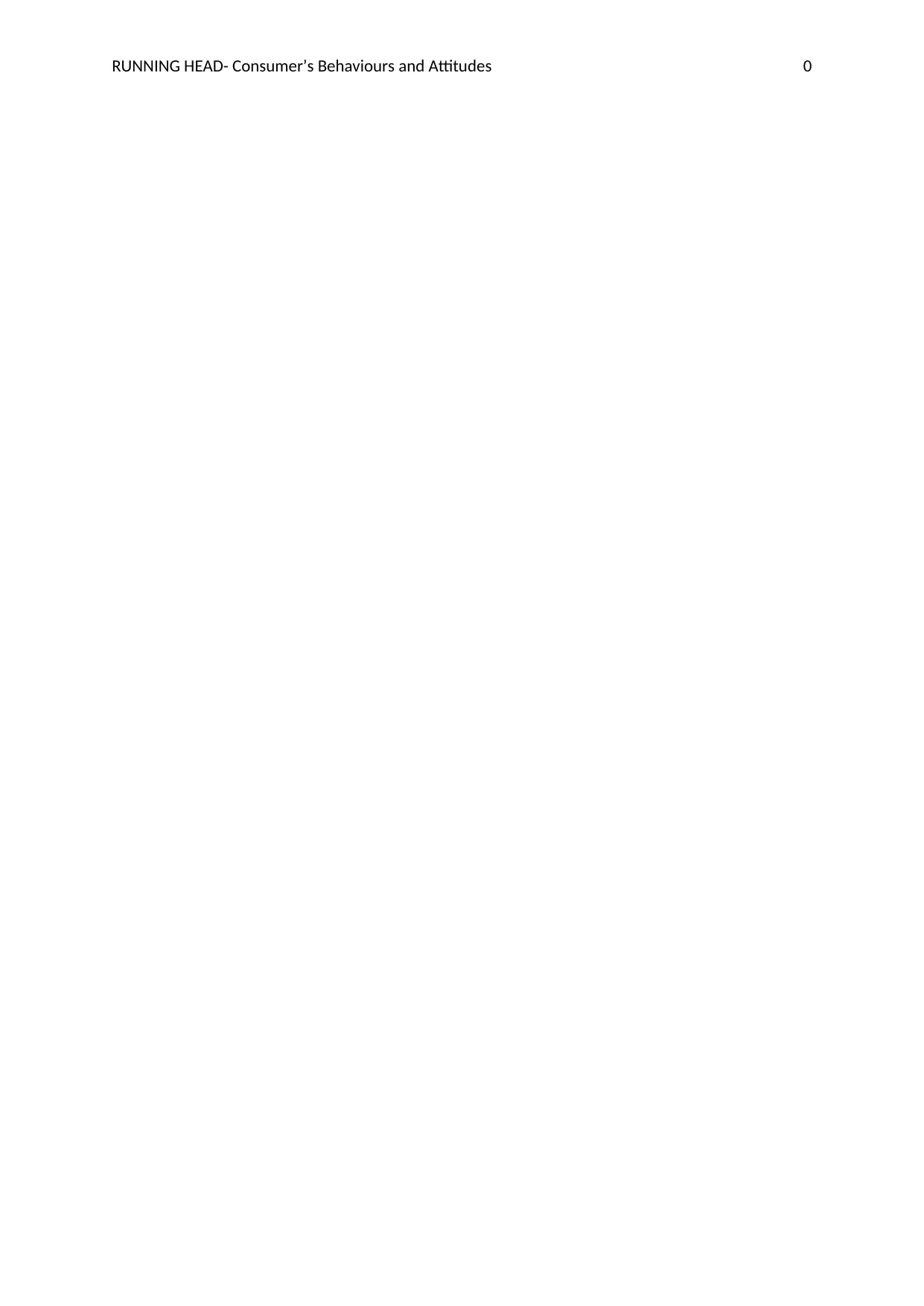
RUNNING HEAD- Consumer’s Behaviours and Attitudes 0
Paraphrase This Document
Need a fresh take? Get an instant paraphrase of this document with our AI Paraphraser
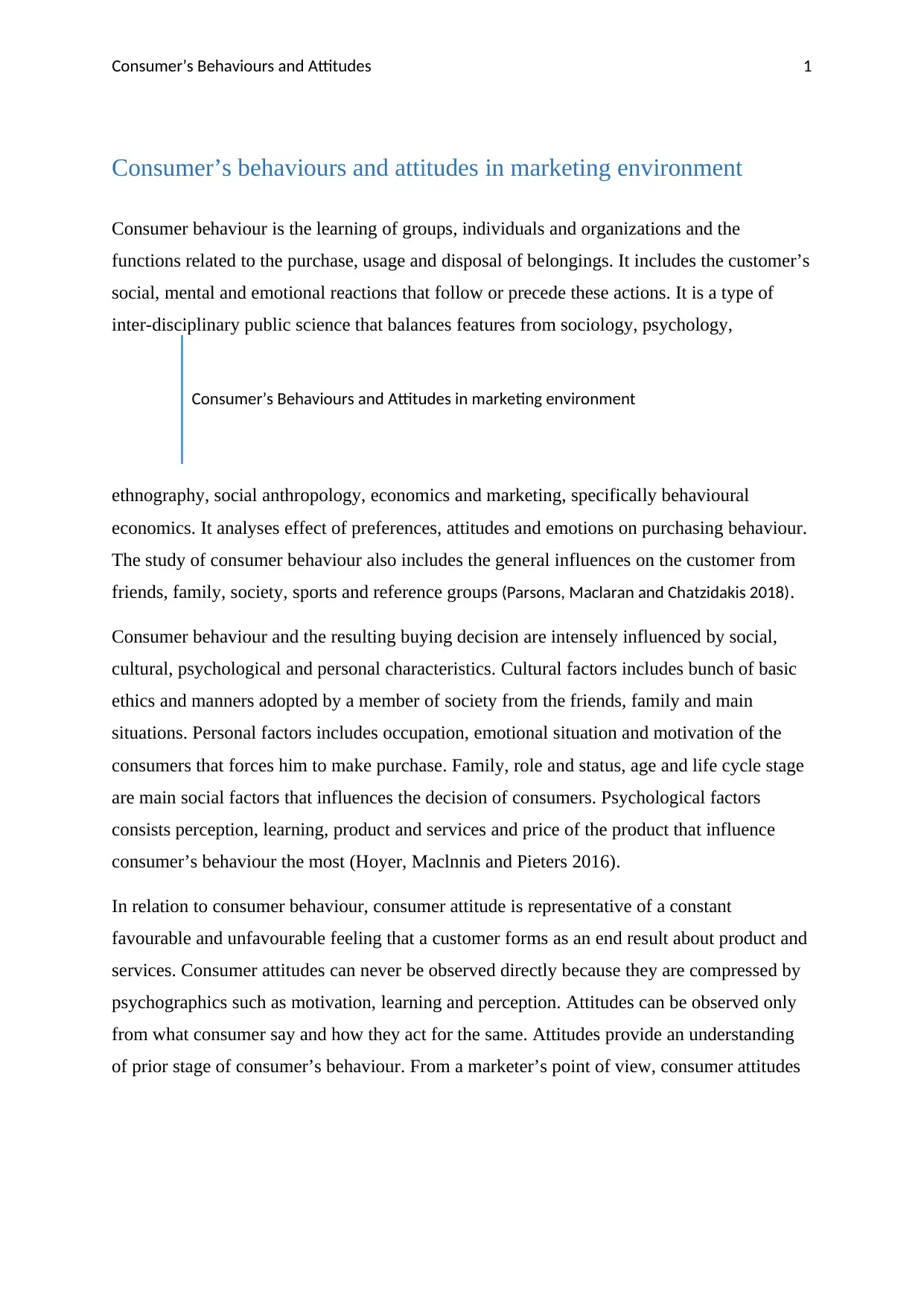
Consumer’s Behaviours and Attitudes 1
Consumer’s behaviours and attitudes in marketing environment
Consumer behaviour is the learning of groups, individuals and organizations and the
functions related to the purchase, usage and disposal of belongings. It includes the customer’s
social, mental and emotional reactions that follow or precede these actions. It is a type of
inter-disciplinary public science that balances features from sociology, psychology,
ethnography, social anthropology, economics and marketing, specifically behavioural
economics. It analyses effect of preferences, attitudes and emotions on purchasing behaviour.
The study of consumer behaviour also includes the general influences on the customer from
friends, family, society, sports and reference groups (Parsons, Maclaran and Chatzidakis 2018).
Consumer behaviour and the resulting buying decision are intensely influenced by social,
cultural, psychological and personal characteristics. Cultural factors includes bunch of basic
ethics and manners adopted by a member of society from the friends, family and main
situations. Personal factors includes occupation, emotional situation and motivation of the
consumers that forces him to make purchase. Family, role and status, age and life cycle stage
are main social factors that influences the decision of consumers. Psychological factors
consists perception, learning, product and services and price of the product that influence
consumer’s behaviour the most (Hoyer, Maclnnis and Pieters 2016).
In relation to consumer behaviour, consumer attitude is representative of a constant
favourable and unfavourable feeling that a customer forms as an end result about product and
services. Consumer attitudes can never be observed directly because they are compressed by
psychographics such as motivation, learning and perception. Attitudes can be observed only
from what consumer say and how they act for the same. Attitudes provide an understanding
of prior stage of consumer’s behaviour. From a marketer’s point of view, consumer attitudes
Consumer’s Behaviours and Attitudes in marketing environment
Consumer’s behaviours and attitudes in marketing environment
Consumer behaviour is the learning of groups, individuals and organizations and the
functions related to the purchase, usage and disposal of belongings. It includes the customer’s
social, mental and emotional reactions that follow or precede these actions. It is a type of
inter-disciplinary public science that balances features from sociology, psychology,
ethnography, social anthropology, economics and marketing, specifically behavioural
economics. It analyses effect of preferences, attitudes and emotions on purchasing behaviour.
The study of consumer behaviour also includes the general influences on the customer from
friends, family, society, sports and reference groups (Parsons, Maclaran and Chatzidakis 2018).
Consumer behaviour and the resulting buying decision are intensely influenced by social,
cultural, psychological and personal characteristics. Cultural factors includes bunch of basic
ethics and manners adopted by a member of society from the friends, family and main
situations. Personal factors includes occupation, emotional situation and motivation of the
consumers that forces him to make purchase. Family, role and status, age and life cycle stage
are main social factors that influences the decision of consumers. Psychological factors
consists perception, learning, product and services and price of the product that influence
consumer’s behaviour the most (Hoyer, Maclnnis and Pieters 2016).
In relation to consumer behaviour, consumer attitude is representative of a constant
favourable and unfavourable feeling that a customer forms as an end result about product and
services. Consumer attitudes can never be observed directly because they are compressed by
psychographics such as motivation, learning and perception. Attitudes can be observed only
from what consumer say and how they act for the same. Attitudes provide an understanding
of prior stage of consumer’s behaviour. From a marketer’s point of view, consumer attitudes
Consumer’s Behaviours and Attitudes in marketing environment
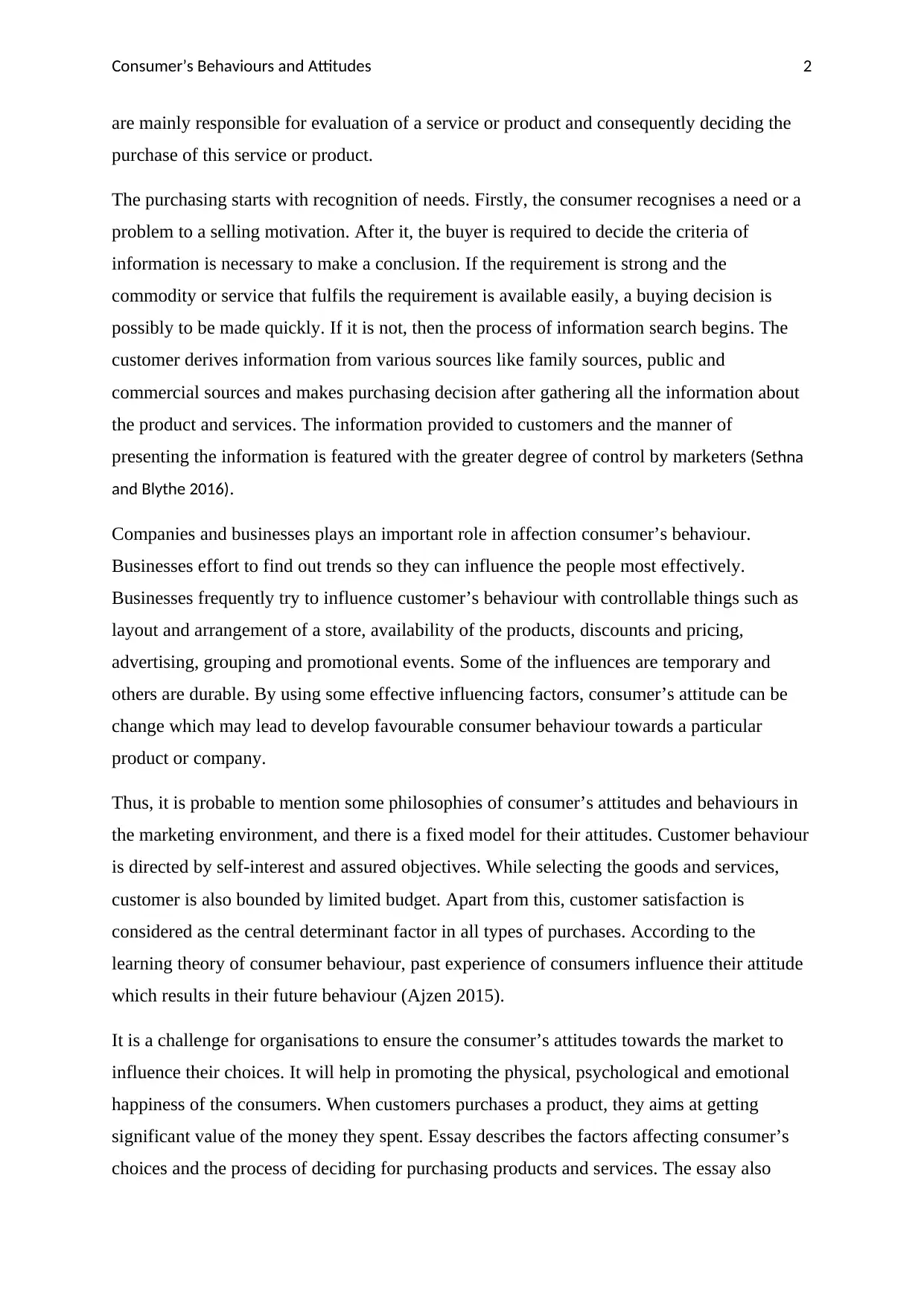
Consumer’s Behaviours and Attitudes 2
are mainly responsible for evaluation of a service or product and consequently deciding the
purchase of this service or product.
The purchasing starts with recognition of needs. Firstly, the consumer recognises a need or a
problem to a selling motivation. After it, the buyer is required to decide the criteria of
information is necessary to make a conclusion. If the requirement is strong and the
commodity or service that fulfils the requirement is available easily, a buying decision is
possibly to be made quickly. If it is not, then the process of information search begins. The
customer derives information from various sources like family sources, public and
commercial sources and makes purchasing decision after gathering all the information about
the product and services. The information provided to customers and the manner of
presenting the information is featured with the greater degree of control by marketers (Sethna
and Blythe 2016).
Companies and businesses plays an important role in affection consumer’s behaviour.
Businesses effort to find out trends so they can influence the people most effectively.
Businesses frequently try to influence customer’s behaviour with controllable things such as
layout and arrangement of a store, availability of the products, discounts and pricing,
advertising, grouping and promotional events. Some of the influences are temporary and
others are durable. By using some effective influencing factors, consumer’s attitude can be
change which may lead to develop favourable consumer behaviour towards a particular
product or company.
Thus, it is probable to mention some philosophies of consumer’s attitudes and behaviours in
the marketing environment, and there is a fixed model for their attitudes. Customer behaviour
is directed by self-interest and assured objectives. While selecting the goods and services,
customer is also bounded by limited budget. Apart from this, customer satisfaction is
considered as the central determinant factor in all types of purchases. According to the
learning theory of consumer behaviour, past experience of consumers influence their attitude
which results in their future behaviour (Ajzen 2015).
It is a challenge for organisations to ensure the consumer’s attitudes towards the market to
influence their choices. It will help in promoting the physical, psychological and emotional
happiness of the consumers. When customers purchases a product, they aims at getting
significant value of the money they spent. Essay describes the factors affecting consumer’s
choices and the process of deciding for purchasing products and services. The essay also
are mainly responsible for evaluation of a service or product and consequently deciding the
purchase of this service or product.
The purchasing starts with recognition of needs. Firstly, the consumer recognises a need or a
problem to a selling motivation. After it, the buyer is required to decide the criteria of
information is necessary to make a conclusion. If the requirement is strong and the
commodity or service that fulfils the requirement is available easily, a buying decision is
possibly to be made quickly. If it is not, then the process of information search begins. The
customer derives information from various sources like family sources, public and
commercial sources and makes purchasing decision after gathering all the information about
the product and services. The information provided to customers and the manner of
presenting the information is featured with the greater degree of control by marketers (Sethna
and Blythe 2016).
Companies and businesses plays an important role in affection consumer’s behaviour.
Businesses effort to find out trends so they can influence the people most effectively.
Businesses frequently try to influence customer’s behaviour with controllable things such as
layout and arrangement of a store, availability of the products, discounts and pricing,
advertising, grouping and promotional events. Some of the influences are temporary and
others are durable. By using some effective influencing factors, consumer’s attitude can be
change which may lead to develop favourable consumer behaviour towards a particular
product or company.
Thus, it is probable to mention some philosophies of consumer’s attitudes and behaviours in
the marketing environment, and there is a fixed model for their attitudes. Customer behaviour
is directed by self-interest and assured objectives. While selecting the goods and services,
customer is also bounded by limited budget. Apart from this, customer satisfaction is
considered as the central determinant factor in all types of purchases. According to the
learning theory of consumer behaviour, past experience of consumers influence their attitude
which results in their future behaviour (Ajzen 2015).
It is a challenge for organisations to ensure the consumer’s attitudes towards the market to
influence their choices. It will help in promoting the physical, psychological and emotional
happiness of the consumers. When customers purchases a product, they aims at getting
significant value of the money they spent. Essay describes the factors affecting consumer’s
choices and the process of deciding for purchasing products and services. The essay also
⊘ This is a preview!⊘
Do you want full access?
Subscribe today to unlock all pages.

Trusted by 1+ million students worldwide
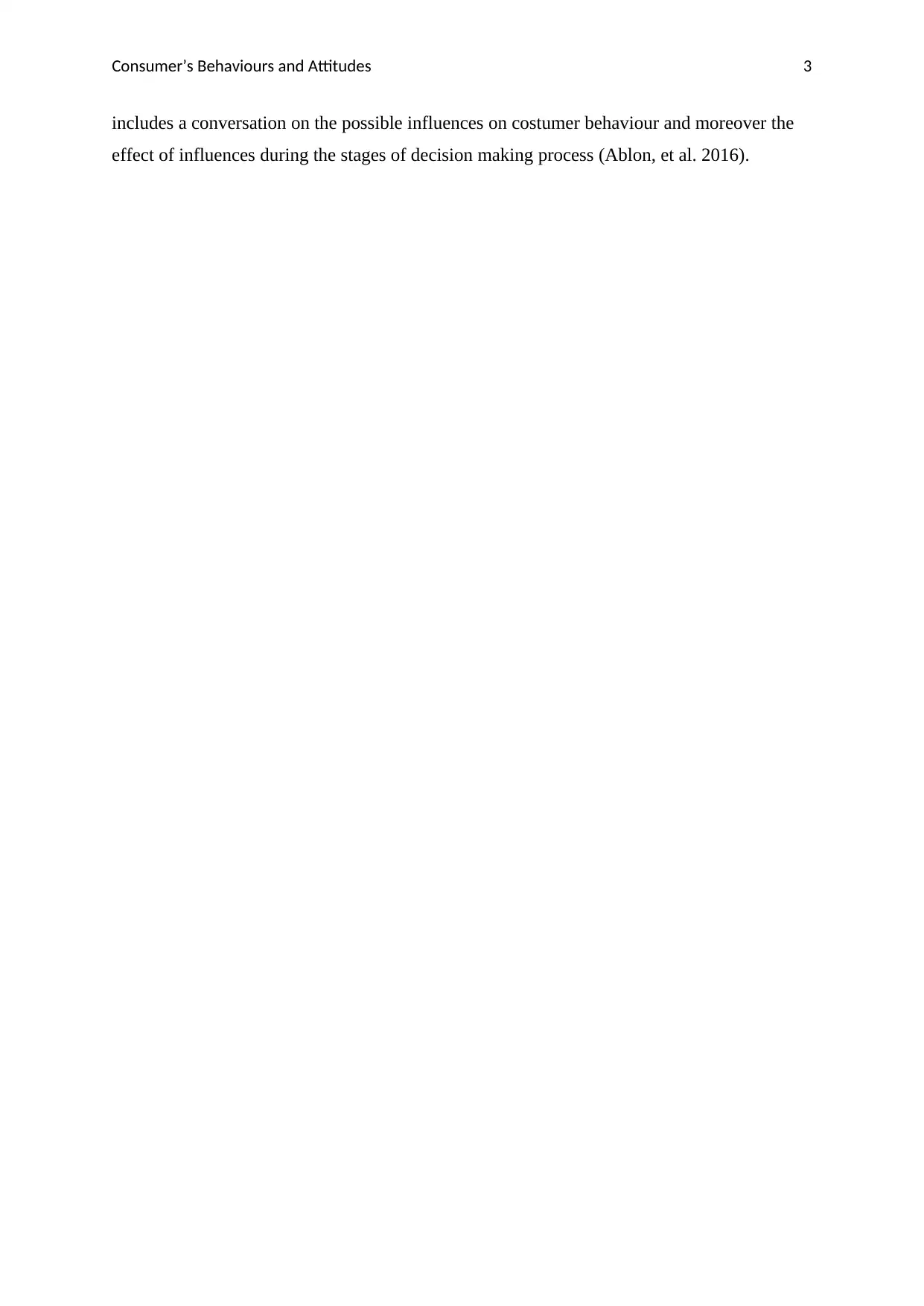
Consumer’s Behaviours and Attitudes 3
includes a conversation on the possible influences on costumer behaviour and moreover the
effect of influences during the stages of decision making process (Ablon, et al. 2016).
includes a conversation on the possible influences on costumer behaviour and moreover the
effect of influences during the stages of decision making process (Ablon, et al. 2016).
Paraphrase This Document
Need a fresh take? Get an instant paraphrase of this document with our AI Paraphraser
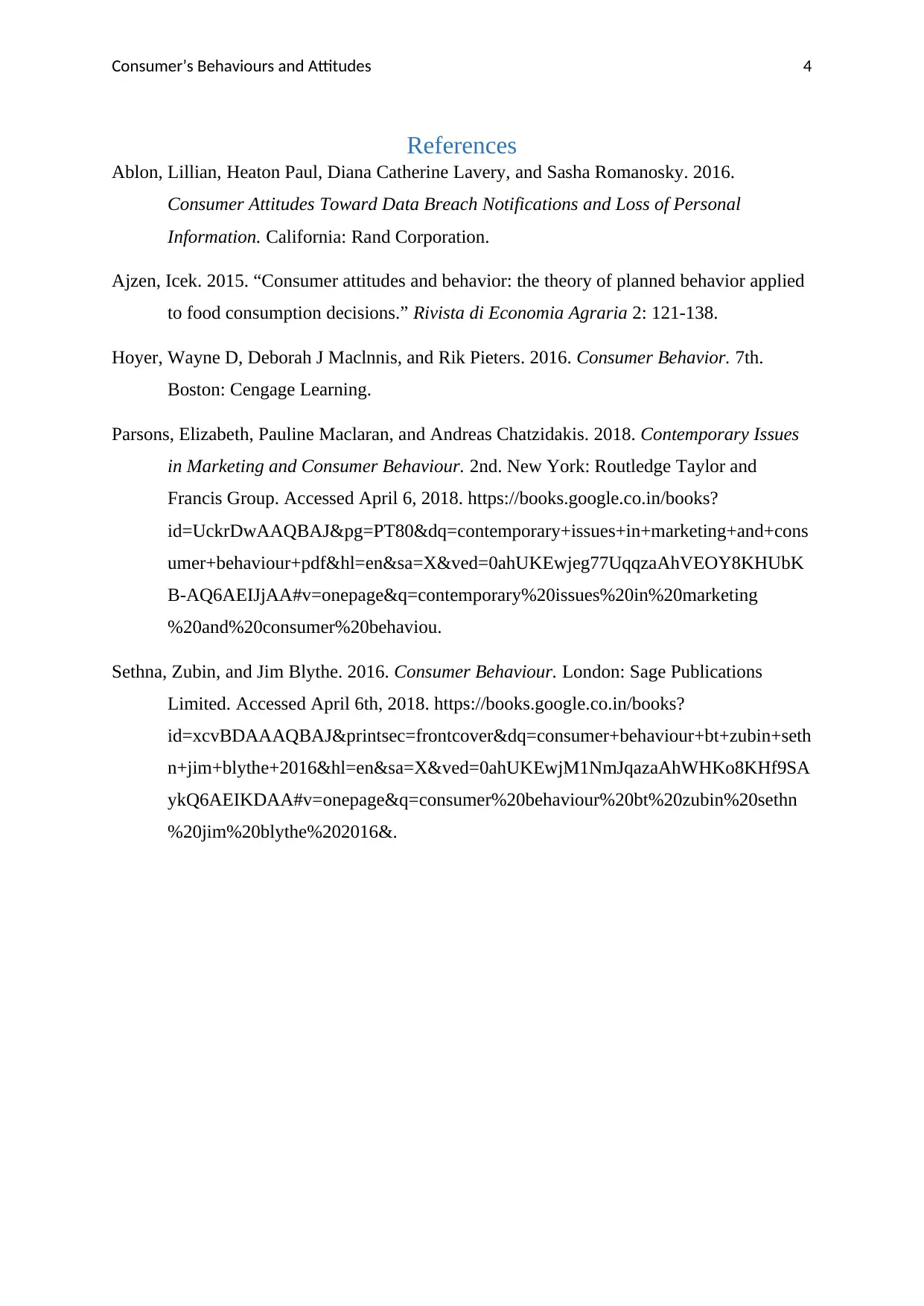
Consumer’s Behaviours and Attitudes 4
References
Ablon, Lillian, Heaton Paul, Diana Catherine Lavery, and Sasha Romanosky. 2016.
Consumer Attitudes Toward Data Breach Notifications and Loss of Personal
Information. California: Rand Corporation.
Ajzen, Icek. 2015. “Consumer attitudes and behavior: the theory of planned behavior applied
to food consumption decisions.” Rivista di Economia Agraria 2: 121-138.
Hoyer, Wayne D, Deborah J Maclnnis, and Rik Pieters. 2016. Consumer Behavior. 7th.
Boston: Cengage Learning.
Parsons, Elizabeth, Pauline Maclaran, and Andreas Chatzidakis. 2018. Contemporary Issues
in Marketing and Consumer Behaviour. 2nd. New York: Routledge Taylor and
Francis Group. Accessed April 6, 2018. https://books.google.co.in/books?
id=UckrDwAAQBAJ&pg=PT80&dq=contemporary+issues+in+marketing+and+cons
umer+behaviour+pdf&hl=en&sa=X&ved=0ahUKEwjeg77UqqzaAhVEOY8KHUbK
B-AQ6AEIJjAA#v=onepage&q=contemporary%20issues%20in%20marketing
%20and%20consumer%20behaviou.
Sethna, Zubin, and Jim Blythe. 2016. Consumer Behaviour. London: Sage Publications
Limited. Accessed April 6th, 2018. https://books.google.co.in/books?
id=xcvBDAAAQBAJ&printsec=frontcover&dq=consumer+behaviour+bt+zubin+seth
n+jim+blythe+2016&hl=en&sa=X&ved=0ahUKEwjM1NmJqazaAhWHKo8KHf9SA
ykQ6AEIKDAA#v=onepage&q=consumer%20behaviour%20bt%20zubin%20sethn
%20jim%20blythe%202016&.
References
Ablon, Lillian, Heaton Paul, Diana Catherine Lavery, and Sasha Romanosky. 2016.
Consumer Attitudes Toward Data Breach Notifications and Loss of Personal
Information. California: Rand Corporation.
Ajzen, Icek. 2015. “Consumer attitudes and behavior: the theory of planned behavior applied
to food consumption decisions.” Rivista di Economia Agraria 2: 121-138.
Hoyer, Wayne D, Deborah J Maclnnis, and Rik Pieters. 2016. Consumer Behavior. 7th.
Boston: Cengage Learning.
Parsons, Elizabeth, Pauline Maclaran, and Andreas Chatzidakis. 2018. Contemporary Issues
in Marketing and Consumer Behaviour. 2nd. New York: Routledge Taylor and
Francis Group. Accessed April 6, 2018. https://books.google.co.in/books?
id=UckrDwAAQBAJ&pg=PT80&dq=contemporary+issues+in+marketing+and+cons
umer+behaviour+pdf&hl=en&sa=X&ved=0ahUKEwjeg77UqqzaAhVEOY8KHUbK
B-AQ6AEIJjAA#v=onepage&q=contemporary%20issues%20in%20marketing
%20and%20consumer%20behaviou.
Sethna, Zubin, and Jim Blythe. 2016. Consumer Behaviour. London: Sage Publications
Limited. Accessed April 6th, 2018. https://books.google.co.in/books?
id=xcvBDAAAQBAJ&printsec=frontcover&dq=consumer+behaviour+bt+zubin+seth
n+jim+blythe+2016&hl=en&sa=X&ved=0ahUKEwjM1NmJqazaAhWHKo8KHf9SA
ykQ6AEIKDAA#v=onepage&q=consumer%20behaviour%20bt%20zubin%20sethn
%20jim%20blythe%202016&.
1 out of 5
Related Documents
Your All-in-One AI-Powered Toolkit for Academic Success.
+13062052269
info@desklib.com
Available 24*7 on WhatsApp / Email
![[object Object]](/_next/static/media/star-bottom.7253800d.svg)
Unlock your academic potential
Copyright © 2020–2025 A2Z Services. All Rights Reserved. Developed and managed by ZUCOL.




